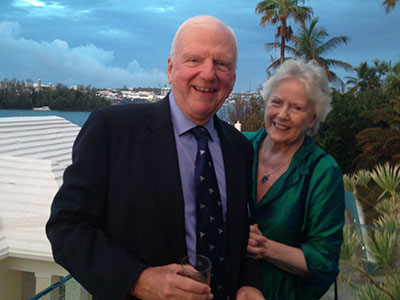Patient Stories
Hearing Aids- My Story

Why am I writing this? To share what I have learned about hearing loss and the importance of doing something about it sooner rather than later.
At 74, I live a very active life style. I work out 2-4 times per week, golf 2-3 times/week, and sail offshore and along the coast whenever possible. I take good care of myself with annual check-ups, reasonable diet and, since retiring, get enough sleep. Despite being a well-organized person, it took me way too long to do something about my hearing loss. This was due to mistaken assumptions about the need for hearing aids to overcome hearing loss and the health risks of not getting them. After many trials and tribulations, I met Nancy Jablonski of Audiology Concierge, and I now hear every word clearly with my Widex BEYOND™ hearing aids.
Hearing Loss History
My mother had hearing loss, so we purchased hearing aids for her. But she seldom wore them, preferring to put them in a drawer. We had to yell at her to be heard and she turned the TV up to a painful level. Meaningful communication got cut way back and her friends became annoyed with her for not using her hearing aids. She withdrew into her little world and eventually she developed dementia and Alzheimer’s. My wife was painfully aware of all this and kept after me to have my hearing tested.
I started to experience difficulty in hearing in my early 50s but believed I did not need hearing aids. However over time difficulty in hearing continued to increase, particularly in social situations where there was background noise. Cocktail parties and restaurants with tables of 6 or more were particularly problematic. I really was not part of the conversation
In time, my hearing in both ears had gotten so bad that I went in for another hearing test and started to learn more about hearing loss and the technology available in today’s modern digital hearing aids.
Procrastination
Many people with hearing loss who would benefit from hearing aids do not buy or wear them. There are many reasons for this including:
- Onset of hearing loss is very gradual, making it easier to ignore
- Rationalization – my hearing is really not that bad and it’s relatively easy to work around i.e. turn up the TV and avoid places where hearing is more of a problem due to ambient noise
- Audiologists test hearing but those that I met did not talk much about hearing aids and most did not recommend I get them; seemed to be a gap between testing and treatment
- Difficulty in obtaining objective information comparing features and functions of hearing aids. The fragmented industry structure is not helpful to consumers trying to select in the best brand from among the 8 leading manufacturers or in finding an objective audiologist to help guide you through the process
- Cost- good, full featured hearing aids cost $5000 to $6000, most of which is not covered by health insurance
- Poor prior experience with hearing aids
- Vanity – not wanting to look old
- Over the Counter inconsistencies- recent legislation allowing inexpensive hearing aids to be sold over the counter is likely to lead to disappointed consumers since making sounds louder, without adjusting for hearing loss at relevant frequencies, won’t improve hearing very much
Hearing Aid Technology
I did my research. Over the last 20 years hearing aid technology has greatly improved. Today’s digital products are far more advanced than what was available 10 to 20 years ago. Features can cancel noise, eliminate feedback, improve high frequency audibility and enable direct connectivity to phones, TVs and music, greatly improving performance while enhancing everyday listening. Remote control of volume, balance, and directional amplification can be carried out via iPhone.
Technology allows hearing aids to be much more selective in what they amplify so that correct amplification can be applied to those frequencies where it is needed and not for those frequencies where amplification is not needed. Noise reduction technology, selective frequency amplification and precise directional microphones work together to help make speech easier to hear.
There is tremendous importance in seeking face to face patient support. I had no idea how complicated the process would be.
Having never tried hearing aids, I did not know how complicated the fitting and acclimation process would be, so I did not appreciate how important close collaboration with my audiologist would be to learn how to use them and to remedy technical issues that inevitably arise. Buying hearing aids is not at all like buying a smart phone or other electronic product. Fortunately for me, I found Audiology Concierge in Old Saybrook, CT. Nancy Jablonski is a highly qualified and very patient audiologist. She and her husband Rene worked with me every step of the way so that today, I am getting the full benefit from my Widex Beyond hearing aids which I wear all day, every day. My days of having difficulty hearing are over.
Nancy provided weekly follow-up visits for fitting, inserting the ear tip into the ear canal, calibration, dealing with wax, correcting feedback (chirping), providing additional programming features, and counseling. I firmly believe that buying hearing aids over the counter or from internet providers would be a mistake because for me, hands-on face-to-face patient support was critical.
A full two decades after first noticing signs of hearing loss, I am now happy with my hearing and improved quality of life as a result. I only regret that I didn’t get the right advice to take action sooner.